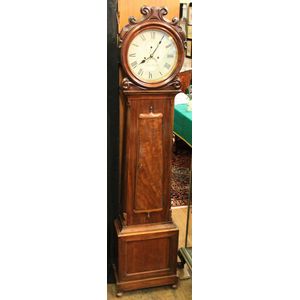French Oak Cane Stool, Late 19th Century
A French oak hole to hole cane stool, late 19th century, the oval stool with a parquetry border to the skirt and raised on tapering, ribbed legs to a stretcher base, height 54 cm, length 50 cm, width 39 cm
You must be a subscriber, and be logged in to view price and dealer details.
Subscribe Now to view actual auction price for this item
When you subscribe, you have the option of setting the currency in which to display prices to $Au, $US, $NZ or Stg.
This item has been sold, and the description, image and price are for reference purposes only.
- Cane in Furniture Making - Cane, as used to make furniture is harvested from the ratan palm. The rattan palm is a type of climbing palm that is native to tropical regions of Asia and Africa. The stem of the rattan palm, also known as cane, is harvested, stripped of its skin, and then used to make a variety of furniture items. Rattan furniture is known for its durability, lightness and natural beauty. The cane is flexible yet strong and can be woven into various patterns, making it suitable for a wide range of furniture styles from traditional to modern. The furniture made from rattan cane is also known for its durability and resistance to extreme weather conditions. Popular items include chairs, tables, sofas, and cabinets. The natural colour of the cane can be preserved or it can be stained or painted for different looks.
- Skirt - In furniture, the skirt is a strip of wood underneath the top or front of the item. On chairs, the skirt is the support under the seat joining the legs, while on tables, the skirt is the support under the top, that assists in supporting the top and also joins the legs. On carcase furniture such as chests and cabinets, the skirt is the timber strip immediately under the drawers or cupboard.
- Oak - Native to Europe and England, oak has been used for joinery, furniture and building since the beginning of the medieval civilisation. It is a pale yellow in colour when freshly cut and darkens with age to a mid brown colour.
Oak as a furniture timber was superceded by walnut in the 17th century, and in the 18th century by mahogany,
Semi-fossilised bog oak is black in colour, and is found in peat bogs where the trees have fallen and been preserved from decay by the bog. It is used for jewellery and small carved trinkets.
Pollard oak is taken from an oak that has been regularly pollarded, that is the upper branches have been removed at the top of the trunk, result that new branches would appear, and over time the top would become ball-like. . When harvested and sawn, the timber displays a continuous surface of knotty circles. The timber was scarce and expensive and was used in more expensive pieces of furniture in the Regency and Victorian periods. - Parquetry - Parquetry is inlay laid in geometric patterns, the contrast being achieved by the opposing angles of the grain and veneers. The herringbone pattern is the most commonly used in flooring, but this is almost never seen in furniture - the patterns used are more complex and unlike flooring, can include several different varieties of timber.
- Stretcher - A horizontal rail which connects the legs of stools, chairs, tables and stands, to provide stabilisation of the legs. A stretcher table is any table with a stretcher base. The term is usually applied to substantial farmhouse tables, although many cabinetmaker's pieces, such as sofa tables, also have turned stretchers.
This item has been included into following indexes:
Visually similar items

Antique Japanese imari pattern jardiniere mounted with later French mounts, approx 14 cm high, 22 cm wide, 11 cm deep
Sold by
in
for
You can display prices in $Au, $US, $NZ or Stg.

A Victorian mahogany work table. 72 cm high, 69 cm wide, 46 cm deep.
Sold by
in
for
You can display prices in $Au, $US, $NZ or Stg.

A William IV mahogany cased 8 day Scottish grandfather clock. Maker J. Bell, Perth. Height: 203 cm
Sold by
in
for
You can display prices in $Au, $US, $NZ or Stg.

A Bosley pottery gnome. Height 69 cm
Sold by
in
for
You can display prices in $Au, $US, $NZ or Stg.
